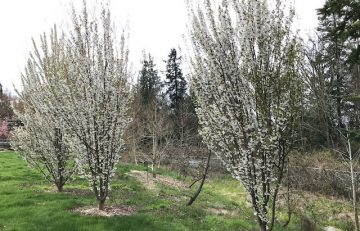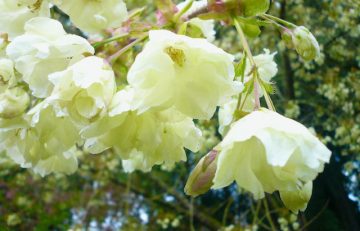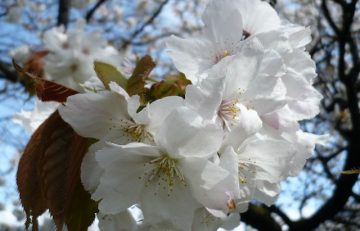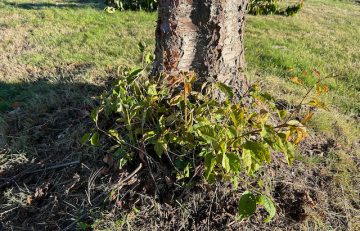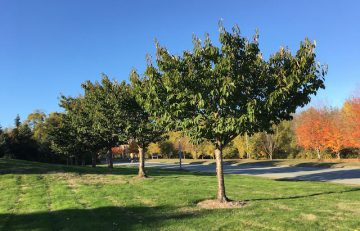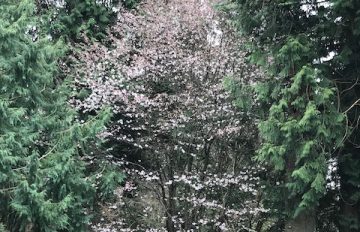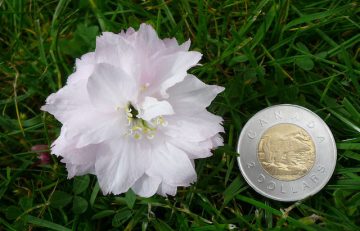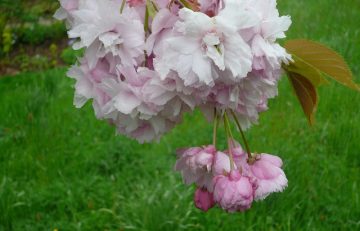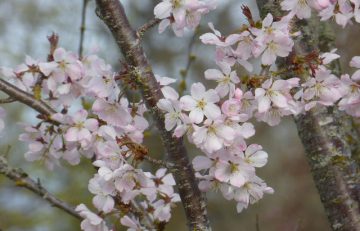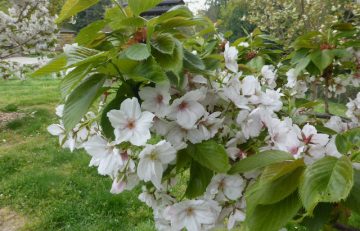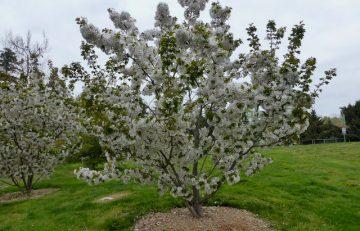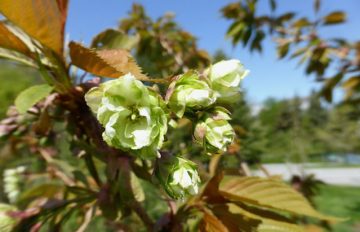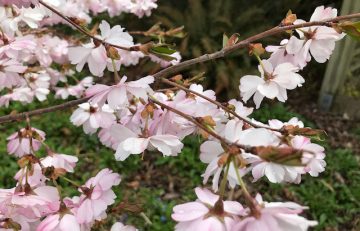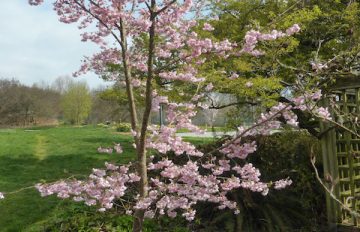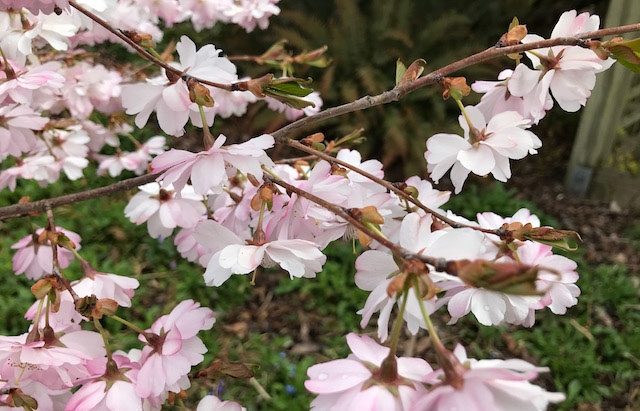
Prunus ‘Accolade’
2024 will go down as an exceptional year for ornamental cherries, but one of the least predictable for timing. For example, the flowering schedule outlined in the handbook Ornamental Cherries in Vancouver, published in 2014 after several years of careful phenological observations, has been mostly turned on its head. Early cherries, like Prunus ‘Accolade’, are still blooming now (in the first week of April), when they typically flower in late February or March. This is a cherry that announces itself with confidence. Its delicate branching and wide spreading crown add considerably to its charm, but people are primarily attracted to the pizzazz of its semi-double, unapologetically bright pink flowers. ‘Accolade’ is a “modern” (i.e., 20th century) cross between the spring cherry, Prunus itosakura, and another Japanese species, Prunus sargentii, which is known in Japan as O-yama-zakura (big mountain cherry—for its large stature). There is a single specimen at the northwest corner of the Reception Centre. Prunus sargentii is normally a reliable bloomer in mid-April, but its flowers have been out for weeks. A group of three is located where Stearn Trail diverges from Upper Asian Way in the Asian Garden. Visitors may be able to see a few lingering flowers from these trees at the normal time, but don’t delay too long. Similarly, Prunus ‘Pandora’ usually opens its soft pink blossoms in mid-April—but not this year. This English hybrid was developed in 1939 by the famous cherry breeder Collingwood “Cherry” Ingram. ‘Pandora’ can be recognized now by its fine, twiggy stems and low-branched, upright form (and maybe still, a few soft-pink flowers).
Luckily, the rarely cultivated and mostly underappreciated cultivars, ‘Mikuruma-gaeshi’ and ‘Ichiyo’ are right next to ‘Pandora’, amongst the daffodils, north of the entrance roundabout. Both are known as sato-zakura or “village cherries” (so named because their origins are obscured by long cultivation around Japanese villages). ‘Ichiyo’ usually flowers in late April, but this year it will be in perfect form before the middle of the month. This ancient cultivar boasts robust growth and sublimely beautiful, soft pink, fully-double flowers. In a typical year, ‘Mikuruma-gaeshi’ follows ‘Ichiyo’ by about a week; however, this year, ‘Mikuruma-gaeshi’ was in full flight on April 1st (no joke). Known by the appropriately evocative “royal carriage returns,” ‘Mikuruma-gaeshi’ has both single and semi-double flowers nearly as large as those of the famously large-flowered “great white cherry,” ‘Tai-haku’. Close up, the exquisite flowers of ‘Mikuruma-gaeshi’ might just take a viewer’s breath away, as they have done since the 15th century in Japan.
There is a row of ‘Tai-haku’, another sato-zakura, west of the entrance to UBC Botanical Garden, parallel to Marine Drive. The single white flowers, the largest of any of the cultivated cherries, emerge from soft-pink buds, and the blossoms contrast with bronzy, barely-emerging leaves. Here, they are all grafted plants, and the overly vigorous commercial rootstock is causing all sorts of havoc; they exhibit the shallow roots and extensive suckering that is all too familiar with grafted cherries. Visitors should be able to recognize that there are significant differences between the grafted and un-grafted trees, not least that the grafted ones show a congested proliferation of scaffold branches at about 175 cm (6’) above the ground, while wider-spaced, more natural-looking branching characterizes un-grafted trees. Note that all of the cherries inside the fence at the Botanical Garden are growing on their own roots, and all of the remaining grafted ‘Tai-haku’ will gradually be replaced by own-root cherries, propagated at our own nursery.
Another of Cherry Ingram’s creations, Prunus ‘Umineko’, opens its white flowers after its grass-green leaves have already started to emerge. This year, the red hearts of the aging flowers are already visible in first week of April (i.e., two weeks early). A group of three of these densely-branched, strongly-upright trees is situated at the western end of the Wharton Cherry Grove, near the corner of the parking lot. The rounded petals apparently suggested to Ingram the feathers of a gull (umineko means “seagull” in Japanese). ‘Ojochin’ (large lantern) at the other end of the Grove, is another old (late 1600s) sato-zakura, though with large, somewhat inflated, lantern-like buds. These open lazily to display opulent, five-petaled flowers (often with an extra, incomplete petal) of the lightest pink.
Like ‘Tai-haku’, ‘Ukon’—a single tree, west of the trio of ‘Ojochin’—has an upright-spreading crown, but its smaller flowers emerge from pinkish buds and open with a yellow cast, as though barely dusted with turmeric (ukon means “turmeric” in Japanese). The flowers are also mostly semi-double—that is, endowed with a few extra petals. Normally opening coincident with ‘Tai-haku’, this year ‘Ukon’ will be at peak bloom in mid-April, which is strangely normal. ‘Gyoiko’ (harlequin cherry), sits a few trees to the northwest of ‘Ukon’. Considered a close relative (it probably originated as a branch mutation of ‘Ukon’), ‘Gyoiko’ blooms about a week later. Both cultivars were known before 1780 in Japan. The harlequin cherry’s extraordinary flowers are white, coloured with prominent green stripes, and backed by a purplish calyx (the collective term for the sepals), and the heart of the flower also sometimes develops purple-red streaks. The name gyoiko refers to a purple, white and green robe worn by noblewomen at court in ancient Japan.
Finally, the cultivar ‘Pink Perfection’ is always our last cherry to flower. A modern English sato-zakura hybrid, ‘Pink Perfection’ was discovered and named in 1935. It is recognized by its abundant large, white-centred, pale-pink, double flowers, and its lax, somewhat disorganized branching habit and generally untidy appearance. There is a small planting spanning both sides of the fence west of the Panabode Building (the old Botanical Garden entrance).
Life isn’t a bowl of cherries. Indeed, in April there are also plenty of rhododendrons, camellias, magnolias, maples, staphyleas, winter hazels, epimediums and more in the Botanical Garden bowl—so come and see for yourself.
- Prunus ‘Umineko’
- Prunus ‘Ukon’
- Prunus ‘Tai-haku’
- Prunus ‘Tai-haku’
- Prunus ‘Tai-haku’
- Prunus sargentii
- Prunus sargentii
- Prunus ‘Pink Perfection’
- Prunus ‘Pink Perfection’
- Prunus ‘Pandora’
- Prunus ‘Ojochin’
- Prunus ‘Ojochin’
- Prunus ‘Mikuruma-gaeshi’
- Prunus ‘Mikuruma-gaeshi’
- Prunus ‘Ichiyo’
- Prunus ‘Ichiyo’
- Prunus ‘Gyoiko’
- Prunus ‘Accolade’
- Prunus ‘Accolade’
Submitted by: Douglas Justice, Associate Director, Horticulture and Collections

